By SYDNEY J. FREEDBERG JR
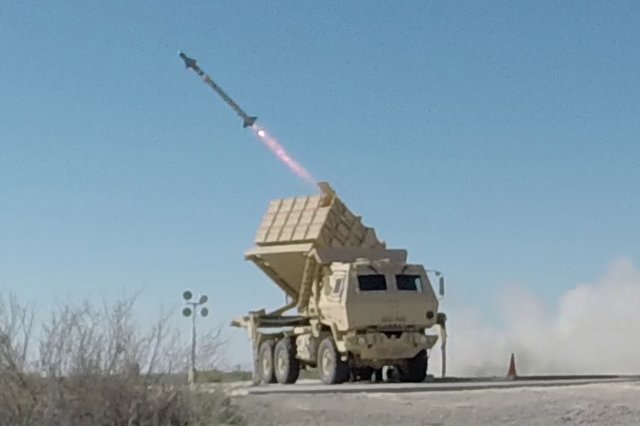 WASHINGTON: The Army is effectively rebooting a key air and missile defense program, IFPC, to refocus it on higher-end threats like cruise missiles. This is just one of the sweeping changes in the service’s $190 billion budget request for 2020, as the service urgently pivots from fighting terrorists to focus on high-tech “strategic competitors,” Russia and China. The Army had planned to spend $517 million on IFPC through 2023, but that’s likely to change when the new numbers come out tomorrow.
WASHINGTON: The Army is effectively rebooting a key air and missile defense program, IFPC, to refocus it on higher-end threats like cruise missiles. This is just one of the sweeping changes in the service’s $190 billion budget request for 2020, as the service urgently pivots from fighting terrorists to focus on high-tech “strategic competitors,” Russia and China. The Army had planned to spend $517 million on IFPC through 2023, but that’s likely to change when the new numbers come out tomorrow.The new approach will tone down some “gold-plated” requirements that asked the Indirect Fire Protection Capability to do too many missions at once, said Brig. Gen. Randall McIntire, director of the Army’s Cross Functional Team for air & missile defense modernization.
“We were trying to make it do two different mission sets, quite frankly,” McIntire told me. IFPC was originally meant to shoot down everything from drones swarms and rocket barrages — large numbers of relatively low-performance threats — to cruise missiles — which come in much smaller numbers but are much harder to catch. The competing demands for long range and lots of shots in a relatively mobile package just proved too much to reconcile.
But now the Army is buying not one but two new systems that take on the lower-end, more tactical threats, allowing IFPC to focus on the higher end cruise missiles. (Ballistic missiles, which are highest and fastest of all, are covered by Patriot and THAAD).
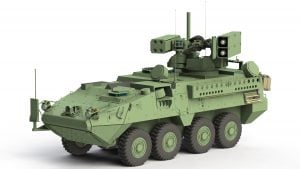 Anti-aircraft Stryker variant chosen by the US Army for its Maneuver Short-Range Air Defense (MSHORAD) mission: 4 Stinger missiles on one side, two Hellfires on the other, with a 30 mm autocannon (and 12.7 mm machinegun) in between (Leonardo DRS)
Anti-aircraft Stryker variant chosen by the US Army for its Maneuver Short-Range Air Defense (MSHORAD) mission: 4 Stinger missiles on one side, two Hellfires on the other, with a 30 mm autocannon (and 12.7 mm machinegun) in between (Leonardo DRS)The first battery of Maneuver Short-Range Air Defense enters service in 2020. MSHORAD mounts a variety of missiles on 8×8 Stryker armored vehicles to protect frontline mechanized forces from drones, helicopters, and attack jets. The first prototype is already in production at General Dynamics’ Lima tank plant; safety testing starts in October. The first battery is operational next year. All in all, the Army plans to buy 144 vehicles for four battalions by 2022. McIntire calls MSHORAD his top priority, just ahead of IFPC.
This year, the Army is also buying two batteries of Israel’s Iron Dome — two command posts, two radars, 12 launchers, and 480 missiles — with delivery expected in 12 to 14 months. Iron Dome has a strong track record against unguided rockets and at least some capability against cruise missiles, although the Iranian-built weapons Israel faces are less sophisticated than Russia’s or China’s. Another issue is that Iron Dome is a bulky system that the Israelis deploy permanently in static sites, but McIntire says it could be redeployed “fairly quickly” on a truckbed, just like the command posts, supply depots, airfields, and other “semi-fixed” sites it will protect. Overall, the Army’s ambivalent about Iron Dome, and it took a direct order from an impatient Congress to get the service to buy it.
Iron Dome launch
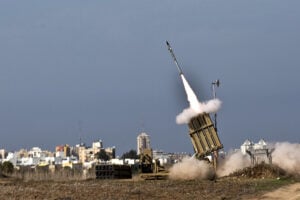 “The trigger really was MSHORAD allowing us to step back and try to not goldplate this thing,” McIntire told me. With MSHORAD and Iron Dome entering service, the Army should have the tactical threats covered. That means IFPC can focus on the other urgent threat — cruise missiles — without being constrained by size requirements to fit on the back of a truck.
“The trigger really was MSHORAD allowing us to step back and try to not goldplate this thing,” McIntire told me. With MSHORAD and Iron Dome entering service, the Army should have the tactical threats covered. That means IFPC can focus on the other urgent threat — cruise missiles — without being constrained by size requirements to fit on the back of a truck.IFPC’s truck-mounted Multiple Missile Launcher was a flawed take on a great concept: a single set of tubes that could fire a wide variety of interceptors depending on the target, from Lockheed’s 28-inch Miniature Hit To Kill to Rafael’s 9.8-foot Tamir — used by Iron Dome — and Raytheon’s 9.9-foot AIM-9X Sidewinder — originally built for fighter jets. But it sounds like the Army was trying pack too much in.
“Some of it’s classified,” McIntire told me, “but….the biggest thing I would tell you is we had some technical challenges with the missile and we weren’t comfortable with the reloading procedures.”
Now the Army can make the IFPC launcher bigger, to accommodate larger missiles, more missiles, or both. “You trade maneuverability for firepower,” he told me. “We’re actually going to be much better off with this approach.”
C-RAM (Counter Rocket, Artillery, & Mortar) firing during a test in Iraq.
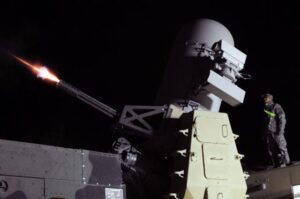 What went wrong with the old approach? The IFPC requirement was written in a different era, for a different threat. Even the acronym stands for “Indirect Fire Protection Capability”: “Indirect fire” typically means either howitzers — which Russia and China do have in abundance — or rockets and mortar shells — a constant threat to US bases in Afghanistan and Iraq at the time. IFPC was in many ways a follow-on to the ad hoc use of naval Phalanx gatling guns for Counter-Rocket, Artillery, & Mortar (C-RAM) defense, meant to be more versatile — for example by taking on cruise missiles as well as RAM — and more mobile.
What went wrong with the old approach? The IFPC requirement was written in a different era, for a different threat. Even the acronym stands for “Indirect Fire Protection Capability”: “Indirect fire” typically means either howitzers — which Russia and China do have in abundance — or rockets and mortar shells — a constant threat to US bases in Afghanistan and Iraq at the time. IFPC was in many ways a follow-on to the ad hoc use of naval Phalanx gatling guns for Counter-Rocket, Artillery, & Mortar (C-RAM) defense, meant to be more versatile — for example by taking on cruise missiles as well as RAM — and more mobile.But as is all too often the case with Army procurement, IFPC’s requirements proved unrealistically ambitious and the technology to meet them took so long to develop that the world it was being built for went away.
“This was a classic case,” McIntire told me. Training & Doctrine Command wrote a requirement without enough input from Army acquisitions. Acquisitions built a product without checking back enough with the requirements writer. They ended up with a weapon that disappointed both sides and took so long to develop that other solutions were invented in the meantime, such as Iron Dome. The newly created Army Futures Command, McIntire noted, is meant to prevent exactly this kind of problem by uniting requirements and acquisition.
“They designed the specs on the Multi-Mission Launcher, and the size of the missiles that go into it, before the return of history,” summed up Tom Karako, a missile defense expert at the Center for Strategic & International Studies. “Now we have a more sophisticated air and missile threat from major powers.”
That said, Karako continued, “maybe it needs to be bigger, maybe it needs to carry different things, but the basic concept of a layered defense in a box, that’s important — and that’s important not to lose.”
SOURCE: Army Multi-Domain Operations Concept, December 2018.
Layered Defense
The Army now envisions IFPC as a key link in a chain of overlapping air and missile defense systems, from the venerable shoulder-fired Stinger to the 20-foot-long THAAD. (The still-larger Ground-Based Interceptor for homeland defense belongs to the Missile Defense Agency). Instead of pure IFPC formations, there’ll be a battery of IFPC in each battalion of MSHORAD to handle threats too high-end for MSHORAD.
Patriot missile launcher
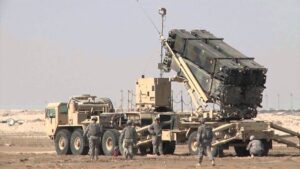 There’ll also be a battery of IFPC in each battalion of Patriots to handle threats too low-end to efficiently kill with Patriots, which can intercept cruise missiles but are optimized against much faster and higher-altitude ballistic missiles. As technology develops, the Army is also optimistic it can complement missiles with laser weapons of various sizes, which offer unlimited shots but don’t work as well in bad weather or at all against targets over the horizon.
There’ll also be a battery of IFPC in each battalion of Patriots to handle threats too low-end to efficiently kill with Patriots, which can intercept cruise missiles but are optimized against much faster and higher-altitude ballistic missiles. As technology develops, the Army is also optimistic it can complement missiles with laser weapons of various sizes, which offer unlimited shots but don’t work as well in bad weather or at all against targets over the horizon.Tying all this together will be the IBCS network. (That’s an awful nested acronym for “Integrated Air & Missile Defense Battle Command System”). IBCS has gone through some well-publicized agonies and delays, but it’s now set to enter service in 2022.
The central idea: Instead of each air and missile defense system coming with its own custom-built launcher, radar, and command post, all of which only work with each other, IBCS will share data from every sensor over the network for any weapon to use. Just today, Northrop Grumman announced it had integrated the first non-US systems into the IBCS network, MBDA’s Common Anti-air Modular Missile (CAMM) family. Even the Israeli Iron Dome, which the Army’s buying complete with its proprietary command posts and radar, will be tested with a prototype IBCS control system and data from US-made radars like the Army’s Sentinel and the Marines’ G/ATOR.
A simplified (yes, really) overview of the Army’s IBCS command-and-control network for air and missile defense.
 That plug-and-play approach is also shaping the competition for the Lower-Tier Air & Missile Defense Sensor, which is holding a “sense off” among potential radars this spring, followed by a contract award in early 2020 and the first unit fielded in 2022, ’23 at the latest. LTAMDS is McIntire’s third priority, after MSHORAD and IFPC. While the radar evolved out of a program to upgrade the Patriot specifically, he now sees it as a key component of the IBCS network broadly.
That plug-and-play approach is also shaping the competition for the Lower-Tier Air & Missile Defense Sensor, which is holding a “sense off” among potential radars this spring, followed by a contract award in early 2020 and the first unit fielded in 2022, ’23 at the latest. LTAMDS is McIntire’s third priority, after MSHORAD and IFPC. While the radar evolved out of a program to upgrade the Patriot specifically, he now sees it as a key component of the IBCS network broadly.As part of that networked approach — and in an effort to avoid another overly ambitious requirement — the Army says it’s willing to accept a LTAMDS radar that, like the current Patriot radar, only covers a given sector of sky and lacks a 360 degree field of view. Instead, the service thinks it can network multiple radars’ partial perspectives together to get a full picture.
CSIS’s Karako thinks that’s a mistake. It’s great to combine data from different radars, he told me, “but you have to actually have the sensors to fuse together” in the first place. Even if IBCS delivers as promised, an adversary could still hack or jam the network. Or a battery might just have to relocate rapidly — to avoid attack, or to keep up with advancing or retreating troops — to an area where the only radar coverage is what it brings with it. In either case, you want your standard-issue radar to be capable of covering all directions by itself, not dependent on the network.
“Either you build in the 360 capability at the battery level,” Karako told me, “or you may not have it.”
The Army still says 360-degree coverage is a desired objective for the radar, just not a mandatory requirement. So it’s entirely possible one or more contractors will not only show up with a 360° system but win the day with it. But we won’t yet even know for sure who all the competitors will be. Raytheon, Lockheed, and Northrop are confirmed, with Israeli Elta rumored. And we won’t see their radars in action until the sense-off starts at White Sands Missile Range in late April.

